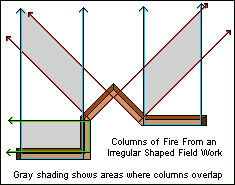
Civil War Field Fortifications
Columns of Fire

Columns of fire were a design convention that assumed that troops lining a parapet would tend to deliver their fire perpendicular to the direction of the parapet. Each face and flank of a field work had its own column of fire that covered an area equal in width to the length of each section of parapet and extending outward to the maximum range of the intended armament of the parapet. Determining the area covered by a field work's columns of fire allowed engineers to design the direction of parapets and the general outline of field works in relation to the areas where the maximum amount of fire would be concentrated against an attacking body of troops and whether the fire striking the enemy would be direct, slanting or enfilading. A carefully designed field work would have its sections of parapet so directed that an enemy attempting to assault the work would be subjected to direct fire for the full length of the attack while being successively hit by slanting and then enfilading fire as the enemy approached the ditch.
Designing a work with its columns of fire in mind also helped engineers avoid major design flaws that might not be immediately evident. Misdirected sections of parapet, especially in re-entrant angles, could place one section of parapet within another section's column of fire, which would be a significant, perhaps fatal, flaw that would inhibit the defending troops' fire and bring about a loss of confidence in the strength of the work. Drawing out columns of fire also helped determine those areas in front of a work where the defender's fire would be weakest. The illustration above shows that the ground in front of the salient angle (in the center of the illustration) would not be covered by fire from any other section of parapet and would therefore have to be strengthen with an artillery armament mounted either en barbette or embrasured to fire across the capital of the salient angle and cover the sector without fire. It should be pointed out that artillery fire was not specifically limited by a work's columns of fire; embrasured artillery would be limited more by the splay of the embrasure than the direction of the parapet and artillery mounted en barbette to fire across the superior slope would be limited by the measure of its traverse.
Back to The Crest of the Interior Slope
Contents Home Page Major Works Minor Works Siege Works
Permanent Fortifications Glossary
Copyright (c) PEM 1997, 1998